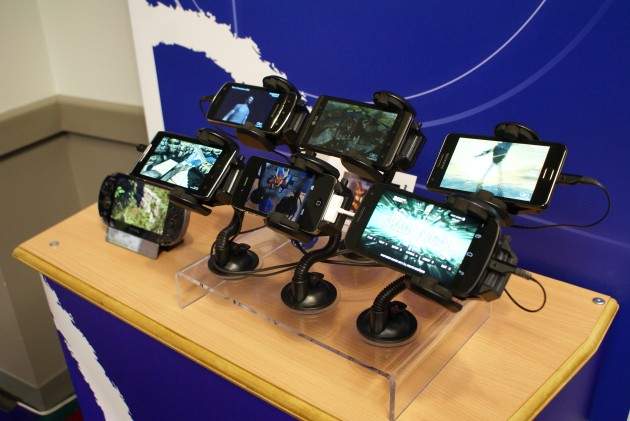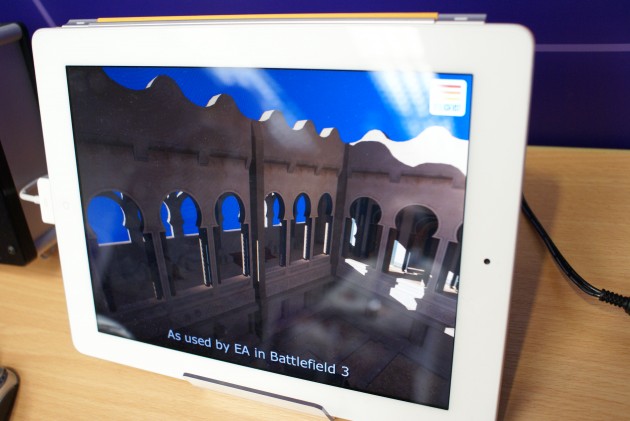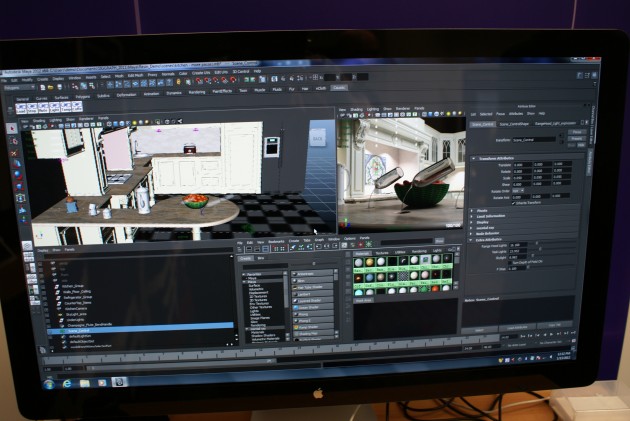Imagination Technologies’ PowerVR is the best graphics technology you never realized you were using. Employed across a wide array of small form-factor mobile devices, PowerVR series chipsets are probably powering your tablet, smartphone, or even handheld gaming device. Even as I took notes in Imagination Technologies’ suite at CES 2012 on my NOOK Color, Director of PR David Harold was quick to point out that even this humble device was driven by a PowerVR GPU.
We were invited to stop by Imagination Technologies’ suite to take a look at not only PowerVR and its implementations, but also to see some other graphical tricks the company has up its sleeves. The area was spacious, and no matter which direction you looked, there were devices showcasing various graphical capabilities of Imagination Technologies’ products.
PowerVR is arguably the most notable of the technologies. As Imagination Technologies’ most popular product, the company has sold over 600 million units of PowerVR processors. The series 5 GPU core is used in many modern mobile devices, including the Galaxy S2, Droid Bionic, Galaxy Nexus, iPhone 4, iPad 2, Galaxy Tab, and even the upcoming PSP Vita, to name but a few. In fact, the PSP Vita is powered a custom 4-core Series 5XT chip, exclusively made for Sony.
The PowerVR Series 5 GPUs finds its popularity largely in part to the technology capabilities of the chip. The Series 5 has full support of geometry, vertex, and pixel shaders, in addition to DirectX 10.1 and OpenGL support (new to 3D terminology? Read this). We were shown a slew of devices, mainly smartphones, that are powered by the Series 5 chip, all demoing impressive real time graphics. One such benchmark showed the Series 5 SGX543 chip rendering between 18-24 million triangles in real time. So basically, you can thank the Series 5 for giving you an enjoyable Angry Birds experience.
In the opening days of CES, Imagination Technologies announced their next generation Series 6 architecture, known as “Rogue”. Though details of the chip are slim, we were told that Rogue supports occlusion culling, tile-based deferred rendering and lossless image compression. Needless to say, gaming on Series 6-powered devices will be superb.
All that power needs power
With this focus on mobile devices, there is an obvious need for PowerVR GPUs to be as energy efficient as possible. We were shown a setup of two PowerVR system-on-a-chip setups performing various types of rendering connected to a meter that displayed the wattage being drawn. In an image editing environment, the SoC was reading .68 watts at idle. When the unit was fired up using the CPU, wattage breached the .7 watt barrier. David then enabled OpenCL rendering on the GPU, freeing up the CPU from the heavy lifting. The meter dipped down to .66 watts. Though it may not seem like much, the difference between .68 and .7 watts is tremendous in the mobile space—a feat made possible by OpenCL support on the GPU.
Next we were shown one of the most impressive demos in the suite. An iPad 2, using PowerVR technology, running a real-time lighting demo. Utilizing the same lighting engine implemented in Battlefield 3, the sequence showcased an open-air stone structure with a looping light cycle. As the light source moved over the environment, complex shadows moved across the geometry. The engine simulated ambient occlusion, radiosity, and cascaded light propagation volumes (color bounce) similar to that found on CryEngine 3. By dragging your finger across the screen, you could adjust the light location in real-time. This was all happening at a smooth 60 frames per second on an iPad 2. It was quite remarkable.
Raytracing
Breaking away from the PowerVR demonstrations, we were given a quick demo of something quite a bit different. A year ago, Imagination Technologies acquired Caustic Graphics. Since then, Caustic have been working on an open API raytracing solution named Brazil. Brazil utilizes the Open Ray Tracing Library (also built by Caustic) to bring incredibly fast ray-traced rendering to various 3D packages. The demo we were given showed a highly complex scene with various glass objects and multiple light sources. In typical ray tracing scenarios, it is not uncommon to see a render take minutes—even hours sometimes. With the Brazil demo, the fully-shaded and ray traced render completed in mere seconds after adjusting the camera in the viewport. It was high quality ray tracing rendered at incredible speeds. Brazil can be implemented in Autodesk Maya, Autodesk 3DS Max, and Rhinoceros.
Imagination Technologies brought out some big guns to CES 2012. They are doing some exciting things in the mobile graphics space. If analysts are so sure the smartphones and tablets will usher in the next big thing in gaming, at least we know the hardware will be up to the task of making it all look fantastic.









 Articles RSS
Articles RSS